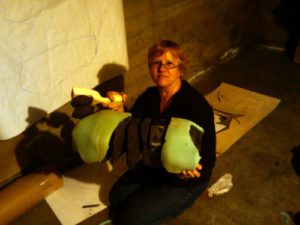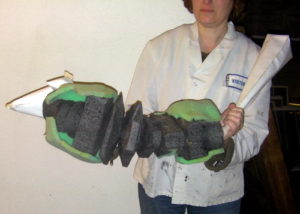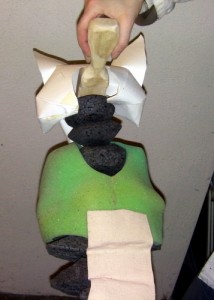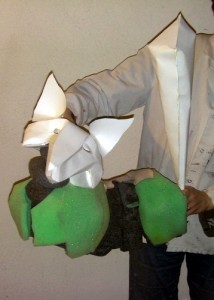 While we were working on Loki, we kept joking that he looked like an alien caterpillar. Here is Jodi in front of the designs for Loki holding the naked puppet. In her right hand is the basswood control for the puppet’s head, minus the head.
While we were working on Loki, we kept joking that he looked like an alien caterpillar. Here is Jodi in front of the designs for Loki holding the naked puppet. In her right hand is the basswood control for the puppet’s head, minus the head.
Her right hand is holding his hindquarters.
The puppet has vertebra and ribs made out of a polyethelene. Rob Kimbro cut those out using the bandsaw and an electric carving knife. You know, the type for carving turkeys.
The puppet also has green crap foam. That’s a technical term meaning really cheap foam. Why? Because I had it around the basement and needed something to smooth the lines of the puppet. At one point, I tried making a simple foam body but… crap foam. It buckled unpleasantly no matter what darts and vents I put into it. Since we had spare foam from Thor we went the more labor intensive, but more graceful, route.

Each vertebra has two pieces of stout bungee running down the center, like a spinal cord. They’ve been beveled to allow free movement but they want to stay in the zero position.
Looking at the puppet’s ventral view, it’s easy to see the beveled pieces where I wanted movement. Loki has a squared off shoulder plate and two fused pieces in the hind quarters.
 Along the back, we glued a piece of Ace bandage which will keep the ribs from rolling into awkward positions while not restricting other movement.
Along the back, we glued a piece of Ace bandage which will keep the ribs from rolling into awkward positions while not restricting other movement.
The goal is to have a range of motion that the puppet wants to do — or more specifically, a range of motion that the puppet resists doing so that is less likely to do something unnatural. By having a zero position that the puppet wants to return to, you free up part of the puppeteers brain for performance.
So much of the job involves fighting gravity in one way or another, that it’s nice when the inanimate object does as much of the job as possible. If that makes sense. So, my goal is to build a fox puppet that wants to move like a fox more than it wants to move like a poltergeist victim.
 And here’s rehearsal Loki, posing for the camera.
And here’s rehearsal Loki, posing for the camera.
The head and tail are made out of watercolor paper for the rehearsal period. Each one is made from a single sheet of paper, folded, cut and scored. If we decide we want the puppet to be larger or smaller, I can easily scale the pattern up or down before transferring it to the paduak veneer that Loki’s final head will be made out of.
As you can see, the puppet is very simple to operate. There’s a rod in the head. To work the tail, one just grabs the tail and wags it.
The tail is held on with another piece of ACE bandage.
The puppet bodies are now in Houston. While Rob Kimbro rehearses with the actors, I’ll be making the final heads and the skins of the puppets.
By the way, just to be blatant about it, if you want to see this production of Odd and the Frost Giants, it’s May 2-21 at Stages Repertory Theater in Houston.
